Michael JÄGER born 1956, Study at the Staatl. Kunstakademie, Düsseldorf, Germany lives and works in Berlin, Germany Exhibitions since 1982, Kunstmuseum Heidenheim, Germany Kunstverein für die Rheinlande und Westfalen, Düsseldorf, Germany Zeche Zollverein, Essen, Germany Kunstverein Freiburg, Germany Kunstverein Heilbronn, Germany Folkwang Museum Essen, Germany Caixa, Madrid, Spain Morat Institute Freiburg, Germany Frank Schlag Gallery, Essen, Germany Gallery Wassermann, Munich, Germany Bellevue Saal, Wiesbaden, Germany Städt. Gallery, Gladbeck, Germany Muka Gallery, Auckland, New-Zealand Galerie Erhard Witzel, Wiesbaden, Germany  Michael Jäger, Kammerbild Nr. 11, Mischtechnik, 36x25 cm, 2001, ... Michael Jäger thus moves along the line that separates the conception of consistency associated with the traditional panel painting from its complete dissolution into unrelated scraps. It is a mark of the quality of his work that it refuses to settle upon either pole, seeking its fortune instead in a structurally conceived space ‘in between’. In its search for pictorial solutions Jäger’s work transmits a sense of longing for the ideal of a self-contained, unified pictorial space, which his extensive, variable, modular disposition of imagery nevertheless surrenders. Taking the above reference to a view through the microscope as a background for Jäger’s paintings, these could well be interpreted as a collision of different molecular systems, observed with amazement by the artist because he knows as little about them as we do. All he does is avail himself of the instant of the collision in order to take notes of the individual particles’ movements, in the sense of a non-hierarchical, comprehensive and well-balanced record. For this to succeed, the frame assigned to these unrelated molecular movements must convey at least a certain impression of unity. In an ambiguity characteristic of Michael Jäger’s integral work, the idea of a storage room, taken either as a repository or a set of shelves, functions in a centring as well as a decentring manner. Stored up, the paintings’ components are saved – not least in the literal meaning of the word – yet not in any systematic way. Therefore Jäger’s storage rooms, far from illustrating a phantasmal order, act as neutral containers for something that cannot be contained. The idea of storage has been consistently developed and given a spatial expansion by Jäger lately. Starting out from panels which accomodate the different picture molecules in a geometric, monochrome, two-dimensional structure, he extends this geometrical duktus right into the exhibition room by way of mural painting. The room thus becomes a container for paintings which in their turn act as reservoirs for paintings. Now the geometric monochrome murals do not themselves make any claim to visualize an authoritative order either. These flat colour surfaces, which forgo spatial illusionism, aim no more at order or representation than the painting panels proper; in fact, their sole immediate purpose is that of self-presentation. This brings them deliberately into competition with the painting panels attached to them. Formally faithful to the idea of panel painting while materially embedded in the larger context of mural painting, the picture loses its status of isolated individual and turns itself, just like the elements contained in it, into a variable module within a whole arrangement of colour surfaces that certifies nothing except its own being there. Jäger’s works focus a vital point, in so far as the question of the individual painting is not simply declared obsolete (as would be easy and is indeed practised in many quarters) but raised in the context of an extended concept of painting – extended, that is, to include the painting as a space-related installation – and unfolded as an inquiry into the uncertainty principle. It is only in an oscillating equilibrium, where the idea of a consistent individual painting is simultaneously sacrificed and upheld, that the making of a painting will be made possible by balancing centripetal and centrifugal forces. This does also imply that the idea of purification of the painting towards a fictitious absolute zero – so essential to modern art – is no longer realizable for Michael Jäger. His own strategy could rather be described as following a principle of controlled ‘depurification’: meaning an approach where nothing ever occurs in a pure or unequivocal state; where things only subsist in a permanent process of crossing over and hybridization. In this sense the geometrical colour surfaces in Jäger’s paintings appear equally close to monochromes and to a denial of the idea of monochromatic autonomy. And the object-likeness of his oddly shaped forms turns out upon closer inspection to be the phantom of a perception preoccupied with identifying the familiar even where only the unfamiliar exists. The painting technique also abides by this structure of ambiguity: while the painterly passages occasionally show a synthetic coolness, the soberness of the plain paint coat in the more monochromatic parts is counteracted by intentional individualities. Purity, we are told, is the death of the picture. The consequence (itself paradoxical) which follows from this finding can be studied at length in Jäger’s works: conceptions which in their absolute, radical ambivalence contemplate depurification as a possibility of speaking of purity without depicting it. Text by: Stephan Berg, in: Positionen. Beobachtungen zum Stand der Malerei in den neunziger Jahren. Folkwang Museum, Essen 1997. Translation by Katrin Grünepütt, Berlin 2005. 
|



